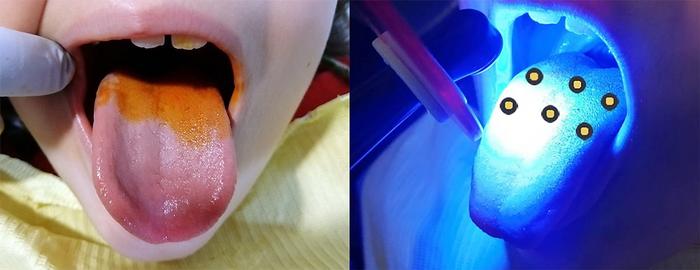A team of Brazilian researchers has demonstrated that a common food coloring derived from the tropical achiote plant, combined with blue light therapy, could offer an effective and accessible treatment for chronic bad breath in children who breathe through their mouths. This innovative approach could provide dentists with an affordable alternative to traditional treatments, potentially improving quality of life for affected children during crucial developmental years.
Published in PLOS ONE | Estimated reading time: 4 minutes
For children who breathe through their mouths, persistent bad breath can be more than just an inconvenience—it can affect their social interactions and psychological development. The condition, known medically as halitosis, often worsens in mouth-breathers because the decreased saliva flow reduces the mouth’s natural cleaning mechanisms. Now, researchers have found that combining annatto—an orange-red dye extracted from achiote seeds—with blue LED light could offer an effective solution.
The study involved 52 children aged 6-12 years who were diagnosed with halitosis using a portable breath meter. The research team divided the participants into two groups: one received the new photodynamic therapy treatment, while the control group used traditional tongue cleaning methods. Both groups followed a standard oral hygiene routine of brushing and flossing three times daily.
The photodynamic therapy process involved spraying an annatto-based solution onto the tongue and exposing it to blue LED light—the same type commonly found in dental offices for tooth filling procedures. This combination triggered a reaction that effectively reduced bacteria causing bad breath. While both groups showed improvement, the children who received the photodynamic therapy demonstrated significantly better results.
“We wanted to develop something that would be readily available to dental professionals,” explains Dr. Sandra Kalil Bussadori, the study’s senior author. “Most dentists already have the necessary LED equipment in their offices, and annatto is a natural, accessible ingredient. This makes the treatment both practical and cost-effective.”
The researchers found that the improvements lasted throughout the 30-day follow-up period, suggesting the treatment could provide lasting benefits. Importantly, the study revealed that in mouth-breathing children, the primary cause of halitosis appears to be oral dryness rather than tongue coating, challenging previous assumptions about the condition.
Glossary
- Halitosis: The medical term for chronic bad breath, which can be caused by various oral or systemic conditions
- Photodynamic therapy: A treatment that combines a light-sensitive substance with specific wavelengths of light to produce a reaction that can kill harmful cells or bacteria
- Annatto: A natural red-orange dye derived from the seeds of the achiote plant, commonly used in food coloring
What makes this treatment particularly practical for dentists?
It uses LED light equipment that most dentists already have in their offices, combined with an accessible natural dye.
Why do mouth-breathing children often experience worse halitosis?
Mouth breathing reduces saliva flow, which diminishes the mouth’s natural antibacterial and cleansing effects.
How long did the treatment’s effects last in the study?
The improvements were maintained throughout the 30-day follow-up period.
What surprising finding did the researchers make about tongue coating?
They found that in mouth-breathing children, oral dryness rather than tongue coating appeared to be the main cause of halitosis.
Enjoy this story? Subscribe to our newsletter at scienceblog.substack.com.


